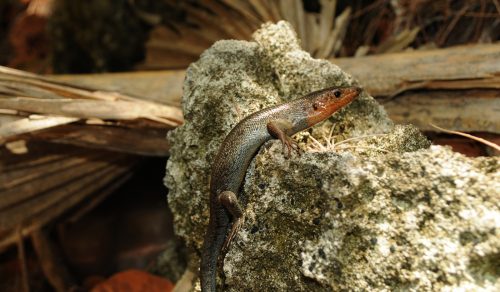Providing the perfect conditions for the animals in our care can be challenging for species whose secretive nature has made them difficult to study in the wild. We use behavioural science to inform husbandry decisions of our animals, particularly our more elusive species.
The Bermuda skink is the only terrestrial vertebrate endemic to the island of Bermuda, and are an important part of the ecosystem and Bermuda’s national heritage. Also known as “rock lizards”, the Bermuda skink is a critically endangered species threatened by habitat loss, invasive species, and pollution. The estimated population size of 2,500 individuals is extremely fragmented, increasing the likelihood that a single storm or fire could wipe out the population. Bermuda skinks are also very mysterious, with few studies detailing their behaviour and ecology in the wild.
 Chester Zoo has been home to a population of Bermuda skinks since 2013, with the first ever successful breeding outside of Bermuda taking place here in 2016. This population provides an invaluable opportunity to learn more about the species.
Chester Zoo has been home to a population of Bermuda skinks since 2013, with the first ever successful breeding outside of Bermuda taking place here in 2016. This population provides an invaluable opportunity to learn more about the species.
Kieran Richardson, a Wildlife Conservation student at the Durrell Institute of Conservation and Ecology (DICE), used video footage to monitor activity, basking, and feeding behaviour of our Bermuda skinks. Kieran tells us what he found:
PSSSTT
The activity patterns in general were bimodal which means that there were two main peaks of activity during the day. Overall, there was a peak in the morning when the skinks first emerged to bask and then this leveled off around midday and then raised again in the afternoon.
Kieran Richardson, Wildlife Conservation student at the Durrell Institute of Conservation and Ecology (DICE)
“This is similar to what has been reported in the wild on Bermuda which is good because it showed that the ex-situ skinks are maintaining behavioural patterns that would exist in the wild. This is hopefully an indication that individuals from this population can be used for reintroduction in the future. There were small amounts of activity during the night as well which has never been recorded for this species before!”

Bermuda skinks are omnivorous and so we fed our skinks a variety of feeds that replicated what would be consumed in the wild, including seasonal fruit, mealworms, and live crickets. Kieran found that our skinks also fed upon live waxworms and a pre-prepared fruit diet typically given to crested geckos. This was reassuring as it confirmed that what we were feeding our skinks was appropriate for the species and suggests that the skinks would benefit from other live food items.
The information gained from Kieran’s project will inform husbandry decisions of our Bermuda skinks, including enclosure design and diet formulation, to better the conservation breeding programme of this highly threatened species. Following Kieran’s work, the activity and breeding behaviour of our skinks will be monitored further. The improved understanding of Bermuda skink behaviour ex-situ will also inform our conservation work of this species in the wild.
OUR TEAM OF EXPERTS WORK IN SIX REGIONS AROUND THE GLOBE – REPRESENTING SOME OF THE PLANET’S MOST BIODIVERSE HABITATS. Discover more about our SCIENCE AND CONSERVATION work.